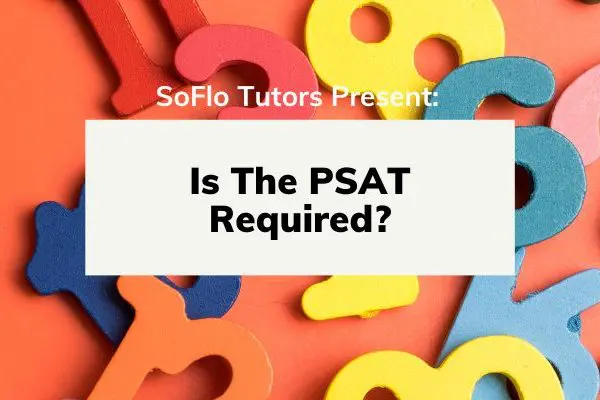
Everything you need to know about the PSAT and why it is important.
What Is PSAT Test
The Preliminary Scholastic Aptitude Test, or the PSAT, is an exam primarily taken by high school sophomores and juniors to prepare for the SAT. There are three versions of the PSAT: PSAT 8/9, PSAT 10, and PSAT/NMSQT that are tailored for different grade levels. You can only take the test once per year, though, and the PSAT/NMSQT, which is taken by eleventh graders, is often considered the most important since this test provides the opportunity to win scholarships through the National Merit Scholarship Program.
The PSAT/NMSQT consists of four sections: Writing and Language, Reading, Math with a calculator, and Math without a calculator. All four sections ask questions in a multiple-choice format, where you will be given four choices of answers. Some sections have several short answer grid-in questions, as well. PSAT/NMSQT scores can range from 320 and 1520, and each of the sections are timed so that the test overall takes 2 hours and 45 minutes to complete.
PSAT Section Breakdown
Each PSAT section tests you on several skills in different subject areas.
Evidence-Based Reading
This section will give you passages or pairs of passages to read and will ask you to answer questions to test your reading comprehension, command of evidence, vocabulary in context, and analytical skills. These passages span several genres, from literature pieces and historical documents, to articles in the social sciences and natural sciences.
Writing and Language
This section will ask you to edit passages that contain deliberate errors. You will be asked to correct grammar, word choice, and edit the paragraph for clarity. These passages cover topics in the humanities, social studies, history, or science and their complexity will vary.
Math (with and without a calculator)
This section will ask you to solve math problems that cover areas important to a variety of situations that will come up in your college major, career, and personal life. This section is divided into two parts: one where you can use a calculator and one where you cannot. There are four main types of math questions in the section:
- Heart of Algebra. This focuses on linear equations and systems.
- Problem Solving and Data Analysis. This focuses on analyzing problems and interpreting information from data.
- Passport to Advanced Math. This focuses on manipulating more complex equations.
- Additional Topics in Math. This focuses on problems related to statistics and probability.
When Do You Take The PSAT
While it is most common for students to take the PSAT during their sophomore and junior years of high school, freshman and eighth graders also have the opportunity to begin their standardized testing preparation early. The three levels of the PSAT offered based on your grade have minor differences between them. Question difficulty is scaled to grade level so that questions in the PSAT 8/9 are generally easier than those in the PSAT/NMSQT.
PSAT 8/9
The PSAT 8/9 is taken by eighth graders and high school freshman and is offered by schools on several dates between September to April. Its sections include:
- Reading: 42 questions in 55 minutes.
- Writing and Language: 40 questions in 30 minutes.
- Math (calculator and no calculator sections): 38 questions in 60 minutes.
- Overall testing time: 2 hours and 25 minutes.
PSAT 10
The PSAT 10 is taken by high school sophomores and is offered by schools in February, March, or April. It is a bit longer than the PSAT 8/9, but is the same length as the PSAT/NMSQT. Its sections include:
- Reading: 47 questions in 55 minutes.
- Writing and Language: 44 questions in 35 minutes.
- Math (calculator and no calculator sections): 48 questions in 70 minutes total.
- Overall testing time: 2 hours and 45 minutes.
PSAT/NMSQT
The PSAT/NMSQT is taken by high school juniors and is the only opportunity to qualify for the National Merit Scholarship program (this is why this test is also called the National Merit Scholarship Qualifying Test—NMSQT). It is offered by schools in the fall. Its sections are:
- Reading: 47 questions in 55 minutes.
- Writing and Language: 44 questions in 35 minutes.
- Math (calculator and no calculator sections): 48 questions in 70 minutes total.
- Overall testing time: 2 hours and 45 minutes.
What Is The PSAT Out Of
Score ranges vary between the three levels of the test.
The overall score ranges of the PSAT 10 and PSAT/NMSQT are exactly the same: 320 to 1520. The PSAT 8/9, instead, has a score range of 240 to 1440.
Students also receive two sections scores, one for Evidence-Based Reading and Writing, which combines Reading and Writing scores, and one for Math, which combines both calculator and non-calculator sections. These two scores add up to your total score. For the PSAT 8/9, section scores range from 120 to 720. For the PSAT 10 and PSAT/NMSQT, section scores range from 160 to 760.
Benchmarks and mean scores also differ between the three levels of tests. Benchmarks are set by College Board as an indicator that the student is on track to be college-ready. Mean scores are helpful in understanding how your score stands in comparison to other students who took the same test. All this information is important to keep in mind when interpreting your own PSAT score and judging your strengths and weaknesses is different subject areas.
| Score Range | Reading/Writing Benchmark | Math Benchmark | Mean | |
| PSAT 8/9 (8th grade) | 240-1440 | 390 | 410 | 813 |
| PSAT 8/9 (9th grade) | 240-1440 | 410 | 450 | 870 |
| PSAT 10 | 320-1520 | 430 | 480 | 934 |
| PSAT/NMSQT | 320-1520 | 460 | 510 | 1014 |
Does The PSAT Matter
Schools often review student’s PSAT scores as a college readiness benchmark, but the PSAT is generally a low-stakes test because your score will not be used in college admissions. That being said, the PSAT can matter especially for high school juniors who want to participate in the National Merit Scholarship competition. This competition gives out millions of dollars in scholarships to high-scoring students across the nation. The process of winning the scholarships, however, is not so simple.
Over 1 million high school juniors take the PSAT/NMSQT nationwide every year, and approximately 50,000 of these students will qualify for recognition based on their high score. Around 34,000 of these students will receive Letters of Commendation from the National Merit Scholarship Corporation. This doesn’t include any scholarship money, but can qualify you for Special Scholarships from corporations and businesses. Additionally, it is a beneficial honor to put on your college application to impress admissions officers.
Juniors who score in the 99th percentile of their state—around 16,000 students—will become National Merit Semifinalists. Once they are semifinalists, students must submit their high school transcript, teacher recommendations, and a personal essay to be considered for scholarship money. There are three types of scholarships that students in this group can win:
- National Merit Corporation Scholarships: $2,500
- Corporate-Sponsored Scholarship Awards: Scholarships from companies or businesses given to students who are children of their employees, youth in their communities, or have plans to pursue a career in their field.
- College-Sponsored Scholarship Awards: Scholarships from some colleges who are hoping to attract top-scorers.
What Is The PSAT Test Value For The Students And Why Take It
Taking the PSAT still holds great value for students even if their scores aren’t reported to colleges as it is one of the most beneficial preparation tools for the SAT, a test score that is heavily factored into college admissions. In general, all students are recommended to take the PSAT in their sophomore and junior years—and oftentimes, schools require it.
The PSAT is the best way to familiarize yourself with the testing environment, format, and style of the SAT.
The PSAT is often compared to the SAT, and while they have some minor differences, such as question difficulty and score range, there are some formats that are exactly the same, such as the format and structure, question styles, and testing environment. The PSAT is the greatest opportunity to familiarize yourself with the SAT since it is the best simulation of taking the SAT and a low-stakes test since your score will not be reported to colleges. While there are many practice tests available online that you can take later on, it’s impossible to replicate the environment of of taking the test with a proctor, under a timed environment, with other students, and probably with some testing-day nerves.
Your PSAT score is a good predictor of how you’ll perform on the SAT.
This statement is true with one caveat: Your PSAT score is a good predictor of how you’ll perform on the SAT without any extra preparation. Therefore, your PSAT score is a good starting point to jump off on in making your standardized testing goals. Once you know your PSAT score, you can decide if you’d like to improve it based on the colleges you’re applying to. Colleges will usually publish the average SAT score of their admitted students, and your score should either meet or exceed it. Conversely, if you find that their average score might be a bit out of reach, even if you decide to study really hard, you might consider alternative schools that admit students with more similar SAT scores as yours.
Your PSAT report is the most insightful tool you can use to structure your study plan.
The PSAT score report is a treasure trove of insightful information to structure your study plan for future SAT’s. Your report will include your total score and section scores, but also identifies skills you could improve and even includes a list of all the questions you got incorrect. You can use this information to gauge your strengths and weaknesses in different subjects and tailor your study plan to address skills that you need to build up. For example, if you received a high “Heart of Algebra” subscore, which refers to Math questions testing you on linear equations, systems of equations, and functions, you don’t need to waste your time heavily reviewing these types of questions. This will make your study plan more effective and will help you improve your score in the most efficient manner possible.
Colleges might try to recruit you.
While your PSAT scores will not be automatically sent to any colleges or considered in your college application, there is an option to share your score with the Student Search Service. This Service will share your score with a huge national database of colleges who might contact you and try to recruit you. This is entirely optional, and a question on the PSAT will ask you if you wish to opt-in to this service. Just be aware that opting into this service often invites an avalanche of college brochures and information packets to arrive at your mailbox.
How To Prepare To Take The PSAT
Some students might wonder what they can do to prepare for the PSAT, and if any preparation is even necessary. Before taking the test, you should at least familiarize yourself with the testing format and structure, so that you know what to expect when you take it. You should also make sure you bring all the required materials to the testing room—your photo ID, registration slip, multiple number 2 pencils, an eraser, and a calculator. You can also bring water and a healthy snack to drink and eat during your breaks.
If you’re an eleventh grader hoping to qualify for the National Merit Scholarship program, though, you should definitely take extra preparations and study for the test. This means taking full-length practice tests, drilling practice questions, and learning time management strategies. Students prepare for the PSAT in many different ways. Some students take the independent study route, creating their own study plan, and using free resources for practice tests and questions. Some students need more structure and encouragement and hire a tutor. While tutoring services aren’t free, they do come with the benefit of a tailored study plan, a person to hold you accountable, and specific tips and strategies that tutors have found worked well in previous successful students taking the test.
Start Preparing Now With SoFlo Tutors
SoFlo Tutors offers one-on-one tutoring with high school students across the nation preparing to take standardized tests. Our tutors attend top universities and scored in the 99th percentile on their SAT. They create tailored study plans and will work with you to increase your chances of getting your target score. Our tutors schedule sessions to your availability and our costs start at $60/hour. Check out our tutoring services to book a session!
About the Author

Andie Pinga is an expert SoFlo tutor and a senior at the University of Pennsylvania double-majoring in Economics and Anthropology. She scored a 35 on her ACT, and when she’s not studying on campus or meeting with friends, Andie enjoys playing the acoustic and electric guitar.









